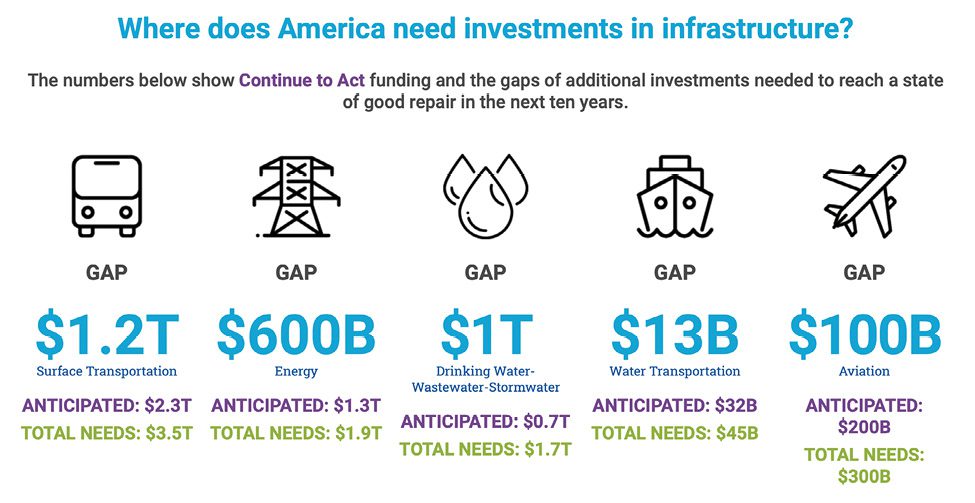We’re all busy delivering on the infrastructure we need to sustain a healthy economy. But have we done our job in letting the world know? The core tenant of engineers’ code of ethics is “to protect public health, safety and welfare.” So, we need to tell the story.
No one under 40 watches the 6 o’clock news or reads the newspaper in the morning. Social media is full of polarizing headlines, articles and manufactured information—yet that’s where many get their “news.” Now, more than ever, we must tell everyone about our country’s failing infrastructure and what we’re doing to fix it. If you’re driving and hit a pothole (which, with driver-assist cars will be a more-frequent occurrence as you have to fight your car to make evasive maneuvers), you complain to everyone about the damage to your car and the time and money it took to fix it.
Change the Narrative
Engineers should talk about how the government needs to design, construct, operate and maintain roads so the pothole doesn’t form in the first place. Most people don’t know or understand anything about infrastructure, so, when it fails, it’s in the headlines with a quick rush to judgement. Infrastructure systems aren’t simple, and it’s our job to communicate the complexities in terms people understand—one on one, every day.
It’s the profession’s responsibility to give you the tools so you can tell the story. That’s why we have a “Report Card for America’s Infrastructure” (infrastructurereportcard.org) and organizations such as the National Infrastructure Advisory Council (bit.ly/4cduzdD) that conduct studies to frame problems and provide recommendations. Spend a few minutes each day educating yourself on contemporary infrastructure issues and start the dialog with everyone who will listen. Be proud of our profession!

Don’t Go Back
In May 2024, the American Society of Civil Engineers (ASCE) released its “Bridging the Gap” report (bit.ly/4duYWNO) that analyzes two possible scenarios through 10- and 20-year timeframes: one in which recent federal spending levels remain in place, referred to as the “Continuing to Act” scenario; and the other in which federal infrastructure investment returns to pre-Bipartisan Infrastructure Law (BIL) levels when the bill expires in 2026, or the “Snapback” scenario.
Infrastructure inefficiencies (e.g., power outages, uneven roads, congested traffic, posted load restrictions on bridges, leaking water pipes, heavy traffic or delays at airports and seaports, etc.) have consequences for businesses and, ultimately, consumers. In the “Continuing to Act” scenario, each U.S. household loses $2,000 per year due to these inadequate systems, while the “Snapback” analysis predicts nearly $2,700 in individual household losses annually, meaning American families save nearly $700 annually when we invest in infrastructure.
These are marked improvements from ASCE’s last economic report, “Failure to Act,” which was issued prior to the passing of the BIL. It estimated households lose $3,300 per year due to faulty infrastructure. However, the federal government alone can’t solve this problem that was decades in the making. State and local governments, in addition to the private sector, must prioritize infrastructure to further reduce costs to households.
Challenges to Businesses
According to “Bridging the Gap,” major sectors such as manufacturing, finance, real estate, healthcare, utilities and agriculture are the most heavily impacted by infrastructure deficiencies. U.S. manufacturers are especially vulnerable to underinvestment because the production of goods (e.g., cars, chemicals, foods, metals, etc.) requires reliable energy, clean water, modern transportation systems and dependable ports for those goods to be shipped. By 2033, the manufacturing sector could lose $1.15 trillion due to inefficient infrastructure in the “Snapback” scenario, compared to $877 billion in the “Continuing to Act” scenario, a difference of $276 billion. The difference in the two scenarios until 2033 is $198 billion for the finance, insurance and real estate industries; $81 billion for healthcare; and $37 billion for mining, utilities and agriculture.
Between now and 2033, the report estimates that nearly $7.4 trillion is needed across 11 infrastructure areas: highways, bridges, rail, transit, drinking water, stormwater, wastewater, electricity, airports, seaports and inland waterways. Under the “Continuing to Act” scenario, approximately $4.5 trillion in investment is anticipated, which covers approximately 60 percent of total needs, leaving a gap of $2.9 trillion. Under the “Snapback” scenario, $3.7 trillion is anticipated, which covers less than 50 percent of total needs and leaves a gap of more than $3.7 trillion by 2033.
Further benefits to the American economy from “Continuing to Act” include:
• More than $1 trillion in gross output by 2033 and $5 trillion by 2043
• More than $45 billion in U.S. exports by 2033 and $244 billion by 2043
• Saving 237,000 jobs in 2033 and 344,000 jobs in 2043
It’s up to us to help our communities realize these benefits. So, get out there and start talking about what you’ve accomplished as well as what you and the industry can still do together as a profession.
The post Engineering the Future: Engineers Must Share Their Infrastructure Stories first appeared on Informed Infrastructure.